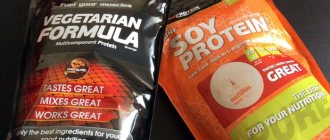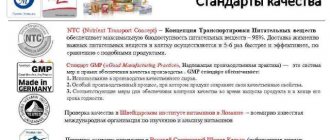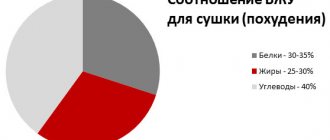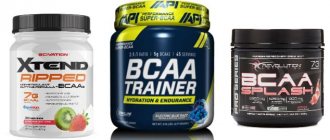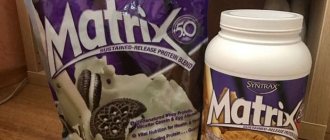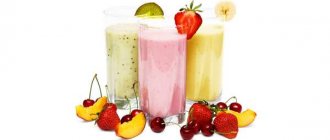22.05.2018
The sports nutrition market is represented by hundreds of brands, but this does not mean that each of them has its own production. Quite the opposite - there are not many factories in the world that make the same whey; for example, in Russia there are no such factories at all.
That is, all sports nutrition (in particular, gainers and proteins) is made from protein produced by a rather narrow range of factories. This nuance is not of much concern to beginners, but for experienced athletes it can be of conceptual significance, including for purely individual reasons.
For example, someone tried a gainer based on the Prolacta 95 protein and was satisfied, whereas with a similar product made using the Lactomin 80 protein, the target effect seemed not so pronounced to the athlete. We decided to consider this issue in detail, focusing on the most popular protein manufacturers, whose raw materials are used in the production of sports nutrition.
Protein Types and Market Trends
Modern protein production plants produce four main types:
- Whey Protein.
- Soy Protein.
- Casein protein.
- Egg Protein.
All of these are dietary, natural, 100% digestible high-protein products made from organic raw materials with low fat and carbohydrate content.
The latest trend in the protein supplement market is the combination of multiple protein products into one product. One option is to combine whey protein with casein. The latter is slowly absorbed by the body and serves as a source of amino acids for the blood for a long time. The combination of casein and whey protein is suitable for both daytime and before bedtime. This makes it possible to avoid catabolism, which can be triggered by a long break between meals due to sleep.
Recently, in the production of protein, soy concentrate has increasingly been added to the final product based on whey protein. It is also absorbed quickly and contains large amounts of glutamine, arginine and BCAAs (a complex of three branched chain amino acids). In addition, soy protein speeds up recovery.
The inclusion of egg protein, which is completely devoid of carbohydrates, in protein preparations increases the activity of the secretion processes of anabolic hormones.
And yet, after conducting a series of comparative analyses, the researchers identified whey protein as the best protein product for stimulating intracellular protein synthesis and muscle growth.
Why is it so important to get enough protein?
During the digestion process, the body breaks down proteins (protein), which comes to us with food, into individual amino acids, which replenish the amino acid pool. The amino acid pool is a reserve source of amino acids that circulates in the blood.
The amino acid pool in the circulatory system readily supplies the cells of our body with amino acids, ensures the supply of those amino acids that we need, and is constantly replenished.
Since our bodies require proteins (protein) and amino acids to produce important molecules in the body, such as enzymes, hormones, neurotransmitters (neurotransmitters) and antibodies - without adequate protein supply, our bodies cannot function well.
Proteins help replace worn-out cells, transport various substances throughout the body, and promote growth and repair.
Eating protein can also increase levels of the hormone glucagon, which helps control fat in our body. Glucagon is released when blood sugar levels drop. The process begins when the accumulated glucogen in the liver is broken down into glucose for our body and the blood glucose level is maintained at a constant level.
It can also help release free fatty acids from fat tissue—in other words, provide fuel for the cells and get the fat to do something useful instead of just sitting in the body.
Whey Protein
This is a concentrated protein that is isolated from whey. The composition includes alpha-lactalbumin and beta-lactoglobulin, globular proteins and about 8% serum albumin. Simply put, this food protein also contains large quantities of the amino acids necessary for the body - valine, leucine and isoleucine (BCAA complex). These are important “building” blocks of muscle tissue, without which protein synthesis and muscle growth are impossible.
Whey protein is absorbed extremely quickly, easily and without residue by the body. This product corresponds to the highest coefficient of biological activity - an indicator that determines the amount of protein absorbed from the volume eaten. Medical research has proven the overall health benefits of whey protein. Its use stimulates the body's resistance to certain cancers, normalizes blood pressure, and strengthens the immune system.
Sports nutrition in Moscow
The choice here is much wider than in all other cities. This also applies to a network of online stores and huge centers where a professional athlete will advise you on all issues. The FUZE Multicomponent Protein brand is very popular. This is a multicomponent protein that is positioned as one of the best. The drug contains whey, milk and other types of protein. The nutritional supplement has an incomparable taste, good quality and low price. Only 600 rubles per 1000. The energy value of one serving is approximately 193 kcal, the supplement helps restore spent amino acids and increase muscle mass. As you can see, high-quality sports nutrition can be quite affordable. Moscow is a city of enormous opportunity and choice; there are goods for everyone.
Production
Liquid whey refers to the by-products of production associated with the coagulation of milk (eg cheese making). The protein content in whey is negligible, and for a long time this by-product was simply classified as waste and poured down the drain. Only after many decades, the development of technology made it possible to establish protein production using equipment that allows the isolation of protein from whey in industrial quantities.
The technology for isolating protein from whey includes several stages. Initially, the process of milk curdling is carried out, the curd and whey are separated. The content of minerals, lactose, lactalbumin in the resulting initial whey does not exceed 5%. In the next step, the liquid product is pasteurized and filtered. The filtered whey protein is then concentrated and dried. The resulting product contains from 60 to 97% protein. The production of whey protein is a rather complex process that is not possible at home.
Making your own supplement
It turns out that you can prepare a protein mixture at home from available products. All that is needed is a little knowledge and patience. So, the process of making sports nutrition is very simple. It is necessary to prepare 10-15 domestic eggs and separate the whites from the yolks. In this case, put the protein (that is, white) in one container, and the yolk in another. It is worth adding another ¾ of warm water to each of them. For better taste of the future composition, you can add pepper and salt.
The mixture obtained at home must be stirred, poured into a saucepan and kept on low heat for a certain time. The composition must be stirred throughout the cooking process to avoid burning. When the protein begins to coagulate, the remaining liquid must be strained through a sieve (you can use gauze), and the resulting mixture must be transferred to a separate bowl.
Essentially, this is a protein made at home from egg whites. What to do with the yolks? Essentially, it’s the same thing you did with protein – the technology doesn’t change a bit. By the way, many athletes prefer not to separate the whites from the yolks, but to cook everything together. It is believed that this way you can get a more high-calorie and healthy composition.
The advantage of such protein prepared at home is its exceptional naturalness, absence of side effects and excellent digestibility. In this case, the preparation itself takes no more than 20-30 minutes.
You can also save time and buy a ready-made protein mixture.
Whey Protein Concentrate (WPC)
When isolating any type of protein, filtration is an integral and one of the most important procedures. When producing protein, whey is passed through a specific sieve, which retains the protein fractions.
The first technology for obtaining a concentrated protein product was the filtration of whey through ceramic membranes with very small holes. Despite their unimaginably small size, molecules of fats and carbohydrates pass freely through such holes, but larger protein fractions settle. Collected from the membrane, the whey protein was sent to high temperatures to dry into protein powder.
The downside to whey protein concentrate is the purity of the filtration. It is technically impossible to obtain holes in the membrane of the same cross-section, so a mixed mass settles, in which the proportion of protein is 35-8 5%, despite the fact that honest manufacturers maintain the protein content in their products at a level of at least 70-80%. As a result, the concentrate is not the purest protein product; it may contain excess carbohydrates and fats, which can lead to excessive gas formation in the body. Whey concentrate is a good solution with limited production funding, and therefore the cheapest on the market. The protein fractions of the protein obtained using this technology retain all their beneficial properties.
WPC Fonterra 80
Fonterra 80 protein is manufactured at the factories of Fonterra Co-operative Group Limited, an international concern headquartered in New Zealand, founded in 2001.
WPC Fonterra 80 has long been one of the most popular bulk proteins in the Russian Federation, but in 2013, as a result of independent research, the bacteria Clostridium botulinum, which causes botulism, was discovered in Fonterra products. For several months, the brand’s products were banned from import into Russia, but the restriction was lifted as it turned out that the research results were false.
Today, the main production of Fonterra protein has been transferred from New Zealand to Lithuania, two identical whey proteins are produced under different brands - WPC Fonterra 80 and WPC Rokiskio 80. The second brand got its name from the new plant in Lithuania - Rokiskio Pieno Gamyba. Popular as protein in bulk.
There are other productions, we focused on the most popular ones, including those with which we work ourselves. The protein we present and products based on it (gainers, protein pancakes) are made from raw materials from Fonterra, Ingredia, Hochdorf, Arla Food, Lactoprot, Lactalis. We work with the Dutch manufacturer Alpha Milkpowders Holland BV, the French company Eurial and the Polish Ovopol.
Whey Protein Isolate (WPI)
Protein isolate is a much purer product. It is obtained through prolonged filtration, also called ion exchange. The result is a dry mass with a protein content of up to 95%. Whey isolate contains virtually no fat or carbohydrate lactose and is ideal for consumption. Very often, manufacturers use a mixture of isolate and concentrate in the finished product, which can significantly reduce the cost of the finished mixture, but the whey protein content does not exceed 70%. Experts recommend carefully reading the information on the label and choosing a product whose main component is isolate.
Russian companies are leaders
However, at the same time, a number of companies operate on the market, whose services are used by many athletes. In particular, Ironman is considered one of the best. According to consumers, this is a brand they can trust. Additionally, it is necessary to announce a small list - these are Russian manufacturers of sports nutrition, which are also among the leaders:
- products from the Leader line.
- RealPump;
- "Fortogen";
- "Aktiformula";
- Ironman;
- XXI Power;
- "Junior" ("Young Athlete");
- LadyFitness;
- ARTLAB;
- Shaper;
- "Vansiton";
- "Extreme"
Whey Protein Hydrolyzate (WPH)
Protein production by hydrolysis, in which large protein molecules are divided into individual fragments. A similar process occurs in the digestive tract and takes a lot of energy from the body. Protein hydrolyzate eliminates this need in the body; the resulting protein is absorbed immediately. Some experts believe that when restoring muscles you should only take hydrolyzate, although it is worth considering that this is the most expensive type of protein. It is worth noting that the capabilities of modern equipment make it possible to adjust hydrolysis in such a way that the content of small protein fractions can be only 3-50%. This can significantly reduce the cost of the product. With a low content of small fragments, such a protein becomes bitter.
Economical option: cheap sports nutrition
Today we are looking at brands from manufacturers with a big name, but affordable at their price. There are such brands in almost every product line. But keep in mind that your health depends on what you eat. You should not save on specialized products, because their quality determines how you will endure high physical activity. Twinlab has good reviews and its 100% Whey Protein Fuel is an excellent combination of the highest quality whey proteins that are easy to dissolve and digest. As a result of taking it, not only muscle mass begins to actively grow, but also endurance noticeably increases, as well as the ability to recover after training. Cheap sports nutrition does not mean bad, this example once again confirms the rule. The cost of this product is 1300 rubles per 1000 g.
Filtering Methods
The production of whey protein primarily involves filtering whey from lactose and fats using one of the following technologies:
- Ultrafiltration is the passage of whey through extremely small holes in a ceramic membrane under high pressure. Large protein fractions settle on the membrane and are sent for further processing.
- Microfiltration is a method of additional filtration of the protein mass obtained as a result of ultrafiltration at low temperature. Thanks to microfiltration, it is possible to additionally filter out fat molecules, reducing their content in the protein mass by 1% or more.
- Ion exchange. To separate protein molecules from lactose, fat and other components, charged ions are introduced into liquid whey, which bind only to the protein. Next, using the potential difference, protein is isolated through the ions. The disadvantages of this filtration method include: the loss of some useful fractions and the entry of intermediate chemicals into the finished product.
- Hydrolysis is the chemical process of breaking down large protein molecules into small parts, which are called peptides and are quickly absorbed by the body.
Dosage and time of administration
It is not difficult to prepare the finished powder at home - you need to mix one serving (about 25-30 grams) with 300-350 grams of milk, water or juice. This composition can be drunk in the morning, before or after going to the gym, or at night (it all depends on the type of protein and the tasks).
In the morning, it is advisable to sweeten the protein shake prepared at home a little by adding glucose to it. If taken at night, it is better to exclude carbohydrates from the composition altogether, giving preference to pure proteins with slow digestibility.
If you want to make a truly effective protein powder, try not to mix the powder with cold liquid. The optimal temperature is about 37 degrees Celsius. In this case, the stomach will happily accept the protein prepared at home and quickly absorb it.
The maximum volume of a cocktail drunk before classes should not exceed 300 ml. In this case, you need to carefully study the composition for the presence of lactose. If you have an intolerance to this component, then it is advisable to take the protein with extreme caution. In case of individual intolerance, it is better to refuse to take the powder.
A protein shake prepared at home should be taken during the “protein window”, when the body especially needs nutrients. The optimal time to drink protein is 35-40 minutes before visiting the gym and 25-40 minutes after.
In addition, after classes you don’t have to limit yourself to just protein made at home. You can supplement your diet with fast carbohydrates, which will help restore energy and help protein be absorbed faster. For example, it is acceptable to eat baked goods, cookies or candy.
In addition, it is advisable to prepare the composition for use early in the morning, between meals and at night. In the first two cases, it is better to drink whey protein (it is absorbed faster by the body), and at night - casein or soy protein.
Protein made in Russia
Russian protein samples appeared on sale relatively recently. Until this time, including the Soviet Union, sources of nutrients for athletes were mainly natural products: eggs, milk, cottage cheese, fish, beef, cereals and legumes. At the same time, their athletic performance sometimes reached legendary levels.
Active protein production in Russia began with an increase in loyalty in the requirements for the quality of food products, including sports nutrition, the use of which began to rapidly gain momentum. Now domestically produced protein is gradually gaining popularity at the global level. Among the most famous brands: Hercules, ATech, PureProtein, Ironman, LadyFitness. Perhaps in the near future, Russian brands will compete with such well-known and oldest protein production corporations as Optimum Nutrition.
Mister protein: how to create food production for athletes from scratch
One day, Artyom’s friend ordered a cover for his student card with an Internet meme in the capital. Delivery from Moscow had to wait three weeks, and the cover cost 450 rubles. At that time, only ordinary boring covers were sold in Novosibirsk, but the student wanted to stand out. Artem looked at the prices of Moscow printing houses - the cost of a cover in a wholesale batch was only 5 rubles. He decided that he could sell fashion covers in Novosibirsk for 200–250 rubles.
To order the first batch, Artem borrowed 10 thousand rubles from his parents. I inserted then popular memes and demotivators into the cover layout, which I downloaded on the Internet, and found a suitable printing house in Moscow. Initially, he expected to negotiate the sale with stationery stores at universities, but they could not complete the purchase - the entrepreneur did not have a legal entity.
Read on RBC Pro
Out of spite Kawasaki: how loyalty defeated competence in Russia Billionaire downshifter: how a mortgage seller got rich by comparing prices So says Gref: there are few people with a “nuclear engine” inside Hiring with a demotion: is it worth hiring a former manager for a linear position
Then Parfenov began selling covers by hand at the entrance to his university - the product turned out to be in demand, the first batch sold out in a few days. The entrepreneur offered to work for the same students and sell covers from universities and hostels for a percentage of sales. Parfenov also promoted products on social networks. After creating a group dedicated to funny covers on VKontakte, people from neighboring cities began to show interest - they began purchasing covers from Parfenov in bulk.
The first business consistently brought in 100–200 thousand rubles. revenue per month. And Parfenov even figured out how to diversify it. One day a student from Tyva approached him and asked him to make a magnet with views of his homeland. It turned out that such souvenirs were in short supply. As with the covers, the entrepreneur found colorful photographs of Tyva on the Internet and ordered a batch of magnets. This time a suitable printing house was found in Novosibirsk. The purchase cost 10–15 rubles. per piece, and he sold magnets to students for 200 rubles. The magnets were flying out at a rate of 100 per day.
For two years, the entrepreneur was engaged in covers and magnets, but over time, competitors appeared, and demand fell. Then the entrepreneur switched to sweatshirts with symbols of Russian universities. He ordered his first sweatshirts from a local manufacturer, but there were many similar clothes on the market. To differentiate himself from competitors, Parfenov decided to supply HoodieBuddie hoodies from the USA, which had headphones built into the hood cords. I ordered in bulk on eBay, and sold first in a group on VKontakte, and then opened an online store. It was made by a university friend for a sweatshirt.
The sale of sweatshirts brought in 200–300 thousand rubles. profit per month. But the business had to be curtailed: in 2014, an official representative of the brand appeared in Russia. He demanded that sales be stopped and that the domain be transferred to the trademark owners. At first, Parfenov tried to negotiate and offered to sell his online store. But in the end, I just had to shut down the business: representatives of the American brand threatened to sue.
All these experiments brought in a little money, but they bore little resemblance to a real business. It could all end at any moment. Parfenov did not even register a legal entity and did not pay taxes, believing that he first needed to test the business model, and only when the company proved its viability, draw up documents. Of course this is not true.
“The activity was systematic and generated large amounts of income, so the entrepreneur was threatened with Article 171 of the Criminal Code of the Russian Federation, providing for a fine of up to 300 thousand rubles, or arrest for up to six months. Why Parfenov did not register a legal entity is unclear to me. Registration is inexpensive, an entrepreneur with similar income could afford the services of an accountant,” says Alexey Ponomarev, a lawyer at the New Arbat Bar Association.
Vasco products (Photo: Nikita Khnyunin for RBC)
Protein dream
In 2014, Artem went to the USA under the Work&Travel program. He worked as an attraction operator, cashier and photographer, and in his spare time he shopped for his Russian friends for a small commission. He soon got tired of hired work, he bought a camera and began selling photographs directly to tourists. Saved up several thousand dollars.
Returning to his homeland, Parfenov decided to fulfill his old dream - to open some kind of production. The solution was found in the kitchen. The entrepreneur has always loved cooking, experimenting with products, and playing sports. He often made oatmeal bars for himself and took them for walks and cycling sessions.
The most popular product on the sports nutrition market is protein. But it is usually sold in powder form, which must be mixed with water or milk. This is not always convenient, especially if the training takes place outside. The entrepreneur decided to make protein bars. “Protein is a common supplement. If the composition does not include preservatives and other chemicals, then it is just protein,” says Vasily Smolny, founder of the Internet project “Mad Drying”.
The entrepreneur planned to spend two weeks on the start: find a technologist, develop the product, package it and start selling. But it was not possible to find a suitable specialist either in Novosibirsk or Moscow. I had to develop the recipe myself in the kitchen. There was almost no information about the food industry in Russian in open sources; English-language websites and forums saved the day.
It ultimately took three months to develop the bar in my own kitchen. The first bars became moldy and dried out. Other samples retained their shape, but laboratory tests at the Novosibirsk Center for Standardization, Metrology and Testing showed that the product was unsuitable. Through trial and error, the entrepreneur achieved the desired result. Tests confirmed that the bars are safe to eat. Parfenov received a certificate for the sale of food products and finally registered an LLC.
The bars contain whey protein isolate, milk protein isolate, soluble corn fiber, peanut butter, glycerin, erythritol, water, flavoring, sucralose. All raw materials are imported: whey protein isolate is imported from France, and peanuts from Argentina. Parfenov buys ingredients from Russian distributors. Moreover, the first batch cost him free - the suppliers gave free samples, which were enough for the first thousand bars.
In addition to protein bars, Parfenov immediately began producing peanut butter. This is an ingredient for bars. The entrepreneur decided that since the paste still needed to be made, it could be packaged separately and sold. He was right—the peanut butter market is growing rapidly. Pasta also contains a lot of protein, so it is interesting for athletes. Over the past two years, about 30 companies producing pasta have appeared in Russia. According to Maria Maltseva, owner of the peanut butter company “King Nut,” there are still few competitors among Russian producers, but their number continues to grow. She had heard about Vasco, but declined to comment on the competitor.
In December 2020, both Vasco branded products were ready for sale. There are now six products in the line: variations of a protein bar and a paste. Anna Novikova, World Class trainer, is wary of Russian sports nutrition brands. She doesn't recommend Vasco bars to women who want to lose weight. But protein bars and pasta, in her opinion, are suitable for men.
Economy Vasco
At first, Parfenov worked alone in his own kitchen - he spent 21 thousand rubles on laboratory tests. In December 2020, he rented a small utility room for production from friends for 5.6 thousand rubles. per month. 200 thousand rubles were spent on the purchase of equipment for packaging, and 30 thousand rubles for the production of pasta. Another 50 thousand rubles. spent on developing and printing the first batches of packaging.
The entrepreneur began selling his products through groups on social networks, then agreed on supplies with several sports nutrition stores in Novosibirsk. He personally delivered the goods to stores, convinced them to try to sell a trial batch, and attacked them with “cold calls.” Many refused: the brand was new and unknown, but after a few months Artem returned again with his offer - the store owners gradually gave up. Revenue in the first month amounted to 50 thousand rubles.
The first employee of Vasco was the girl Parfenova - she was engaged in production while Artem delivered finished products to customers and negotiated with store owners. Now Parfenov already has 20 people working for him: ten people in production, the same number in the office.
The entrepreneur hunted for some employees for several months. The production is led, for example, by Denis Karyukin, former deputy production manager of the local Mars representative office. According to Parfenov, he brought American and Japanese lean manufacturing technologies to the company. Nevertheless, for example, labels are glued manually, because, according to Artyom’s calculations, employee costs are currently cheaper than purchasing special equipment.
Now production occupies about 200 square meters. m. 47 thousand rubles are spent on renting production premises. per month. Another 30 thousand rubles. - for office rent. As demand grew, Artem had to buy additional equipment - in five months, a total of 500 thousand rubles were spent. The savings ran out, so I had to take out a consumer loan from the bank - 100 thousand rubles. Vasco does not have a large warehouse; production works to order.
In promoting, Parfenov relies on the Internet: he spends about 50 thousand rubles monthly. on contextual advertising and social networks. The product is specific, so the price of traffic is low. According to Parfenov’s calculations, every 10 thousand rubles spent on contextual advertising brings in about 200 thousand rubles. revenue.
Now Vasco products are represented in two hundred stores in 40 cities from St. Petersburg to Vladivostok. These are sports nutrition networks “KultLab”, Maximum muscle, “Do4a”, “Academsport”, “Fitness Formula”, Power Way, Strong Fit. Delivery is carried out by transport companies. On average, delivery of a batch costs partner stores 500 rubles. The cost of the bar at retail is 155–170 rubles, partners receive the product for 115 rubles. Competitors' products cost about the same.
According to Stanislav Volkov, manager of the St. Petersburg sports nutrition store Power Way, Vasco representatives contacted them themselves. The products are in demand, but the bars are still far from the top sellers - protein and keratin. Parfenov says that on average it takes three weeks from a “cold call” to a deal.
So far Vasco is developing only in the regions. After the New Year, the entrepreneur plans to go to Moscow. According to Parfenov, 50% of the Russian sports nutrition market is concentrated in the capital, but in the regions, store owners are more loyal to new brands. “Mao Zedong’s strategy - from villages to cities - is working. First you gain experience, then you go to a difficult market,” says Fedor Ovchinnikov, founder of Dodo Pizza. According to him, Vasco has every chance to capture part of this growing market: a weak ruble plays against Western competitors.
View from the outside
“The sugar substitute in Vasco bars confuses me.”
Natalia Rimsha, nutritionist, specialist in nutrition and healthy lifestyle
“Buyers should read the ingredients of popular “healthy” products more carefully. For example, whey protein isolate, unlike concentrate, contains fewer nutrients. Heating it can damage the structure of the protein, then the product will be less digestible. Poor quality peanuts can cause allergies and inflammation. The content of Vasco bars that confuses me is sucralose, a sugar substitute. It is used in dietary dishes and low-calorie products. But sugar substitutes are unhealthy."
“Vasco’s composition is not very natural”
Elena Shifrina, founder of BioFoodLab, manufacturer of Bite bars
“The market is moving towards the development of new technologies that make it possible to use fewer chemicals and provide a natural composition with long shelf life. Vasco's composition is not very natural. These ingredients help reduce costs.
Perhaps someone is looking for bars for themselves in a certain price category and these products will suit them. The market has such great diversification, there is a buyer for every product. For some, price is of primary importance. The bars won’t be healthy, but they won’t do any harm either.”
“The crisis has created enormous opportunities for Russian companies”
Ivan Sidorok, founder of the Mabius culinary startup center, co-owner of the Nizhny Novgorod oil and fat plant
“The healthy food market in Russia has grown by more than 60% over the past five years and reached $178 million in 2020. Until recently, a significant part of the market was represented by imported products, but the crisis has created enormous opportunities for Russian companies.
True, the barrier to entry into the category remains quite high. A food FMCG startup needs a strong team. FMCG requires many competencies, including marketing, sales, food technology, logistics, and purchasing. Financial resources are needed for product development, packaging and branding, as well as working capital.”
Let's sum it up
We reviewed a number of companies that offer sports nutrition. On average, prices are quite affordable, and colorful descriptions convince the buyer that these are quality products. However, when compared with the line of elite manufacturers, whose products have all the necessary certificates and guarantee the highest quality, we see a very big difference in price. The conclusion is that manufacturers save money by using inexpensive raw materials to make the product accessible to the majority. Perhaps, if a quality product seems too expensive, you should take a closer look at homemade protein shakes, chicken, egg and cottage cheese dishes. This diet will provide enough protein, although muscle growth will be slower.
Products
Super Set Milk Protein is used to build muscle mass. It contains a concentrate of milk (potassium caseinate) and whey proteins. In addition, the composition contains crystalline glucose, a vitamin and mineral complex. Athletes have to overcome heavy loads, so calcium phosphate, vitamins A and D, and a full complex of B vitamins are vital. In addition, the composition includes calcium, sodium, potassium, phosphorus, magnesium and zinc. Any other analogs of sports nutrition are much inferior to the original product in terms of quality and nutrient content.
